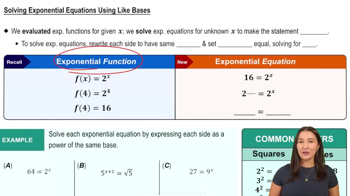Table of contents
- 0. Review of Algebra4h 16m
- 1. Equations & Inequalities3h 18m
- 2. Graphs of Equations43m
- 3. Functions2h 17m
- 4. Polynomial Functions1h 44m
- 5. Rational Functions1h 23m
- 6. Exponential & Logarithmic Functions2h 28m
- 7. Systems of Equations & Matrices4h 6m
- 8. Conic Sections2h 23m
- 9. Sequences, Series, & Induction1h 19m
- 10. Combinatorics & Probability1h 45m
6. Exponential & Logarithmic Functions
Solving Exponential and Logarithmic Equations
Problem 15b
Textbook Question
Solve each equation. In Exercises 11–34, give irrational solutions as decimals correct to the nearest thousandth. In Exercises 35-40, give solutions in exact form. See Examples 1–4. 0.8^x = 4
 Verified step by step guidance
Verified step by step guidance1
<insert step 1: Start by taking the logarithm of both sides of the equation to bring down the exponent. You can use either the common logarithm (log base 10) or the natural logarithm (ln).>
<insert step 2: Apply the logarithmic identity \( \log(a^b) = b \cdot \log(a) \) to the left side of the equation. This will allow you to express the exponent \( x \) as a coefficient.>
<insert step 3: Solve for \( x \) by isolating it on one side of the equation. This involves dividing both sides of the equation by \( \log(0.8) \).>
<insert step 4: Use a calculator to evaluate the logarithms and perform the division to find the decimal approximation of \( x \) to the nearest thousandth.>
<insert step 5: Verify your solution by substituting the value of \( x \) back into the original equation to ensure both sides are equal.>
Recommended similar problem, with video answer:
 Verified Solution
Verified SolutionThis video solution was recommended by our tutors as helpful for the problem above
Video duration:
2mPlay a video:
Was this helpful?
Key Concepts
Here are the essential concepts you must grasp in order to answer the question correctly.
Exponential Equations
Exponential equations are equations in which variables appear as exponents. To solve these equations, one often uses logarithms, which are the inverse operations of exponentiation. For example, in the equation 0.8^x = 4, we can take the logarithm of both sides to isolate the variable x.
Recommended video:

Solving Exponential Equations Using Logs
Logarithms
Logarithms are mathematical functions that help solve for exponents. The logarithm of a number is the exponent to which a base must be raised to produce that number. In the context of the equation 0.8^x = 4, we can apply logarithmic properties to rewrite the equation in a more manageable form, allowing us to solve for x.
Recommended video:

Logarithms Introduction
Rounding and Decimal Approximation
Rounding is the process of adjusting a number to a specified degree of accuracy, often to make it simpler or easier to work with. In this problem, irrational solutions must be expressed as decimals rounded to the nearest thousandth, which involves understanding how to round numbers correctly and the significance of each digit in the decimal representation.
Recommended video:

The Number e

 4:46m
4:46mWatch next
Master Solving Exponential Equations Using Like Bases with a bite sized video explanation from Callie
Start learningRelated Videos
Related Practice












